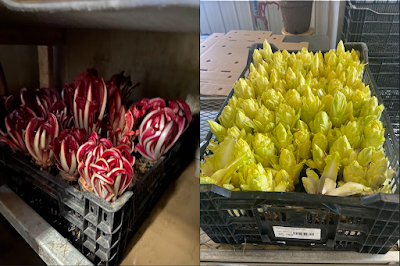Guest article by Peter Skold, Waxwing Farm, Webster, MN
As a part of a Sustainable Agriculture Research and Education (SARE) grant we received, we have been exploring growing forcing chicories as a way of diversifying our farm’s season extension efforts. We learned that these crops can be successfully grown in this part of the country and have the potential to be valuable additions to any vegetable farm’s mix of winter crops.
What are forcing chicories?
Chicories are a family of crops that include radicchio and endive as well as other forage greens. Roasted chicory root has historically been used as a coffee additive/substitute. Forcing chicories are leafy vegetables produced by forcing certain varieties of chicory roots to grow without sunlight. This results in a leafy vegetable that contains no chlorophyll, giving the finished product a unique appearance and flavor.
 |
| Photo 1: Forcing chicories grown on our farm, left: Tardivo radicchio, right: Belgian endive |
We produced two kinds of forcing chicories on our farm - Tardivo radicchio and Belgian endive (see photo 1). Tardivo radicchio is a variety traditionally grown in Northeastern Italy where it was historically forced in covered crates placed in mountain streams. Belgian endive is a more modern product developed in Belgium and adapted for commercial production in the 1800’s. Both varieties grew well in our clay-loam soil in southern Minnesota.
Cultivation
Chicories are similar to lettuce in their cultivation - they prefer cooler temperatures and grow from a single taproot to produce a head of leafy greens. Like lettuce, the seed will not germinate if it is too hot. Chicory can be grown from transplants seeded in a greenhouse or direct seeded in the field. Planting method has an impact on final root shape with direct seeding being necessary to produce a single, well formed taproot. This is more important for endive production than radicchio.
 |
| Photo 2: Forcing chicories in the field. |
 |
| Photo 3: The difference between roots from transplanted (top) and direct seed plants (bottom). |
Forcing chicories are long day crops (100+ days to maturity) so should be planted at the end of June/beginning of July in order to reach full maturity. They need to be kept well weeded and watered in order to produce roots capable of being forced. Roots are ready to be dug in late-October/early-November after a hard frost. An undercutter bar or bed lifter makes the harvesting process manageable on any sort of scale. The roots can be dug and stored like most other root crops at 32-35 degrees fahrenheit and 95+% relative humidity. Radicchio roots are harvested with most greens peeled off, but the inner 10-20% of leaves left intact. Endive greens are trimmed to 1”, taking care to leave the central growing tip intact. Roots can be stored under ideal conditions for months before beginning the forcing process, ensuring a long forcing window throughout the winter months.
Forcing
The final product is produced by forcing the roots to grow in complete darkness producing leaves without chlorophyll. We constructed a forcing system in an unused walk-in cooler which worked perfectly. We created a system of large metal trays plumbed together with a small aquarium pump to circulate and aerate water through the system. We then loaded roots into bulb crates which fit nicely in the metal trays, keeping the bottom of the roots submerged in 3-4” of water.
 |
| Left: Our setup in an unused walk-in cooler, ready to start forcing. Middle (Tardivo Radicchio), Left (endive): Roots loaded into bulb crates and ready for forcing. |
We kept the forcing chamber at approximately 60 degrees fahrenheit and ran the aquarium pump constantly to circulate water through the system. Radicchio was generally ready for harvest after 3 weeks in the forcing chamber while endive required closer to 6 weeks to reach maturity.
 |
| Ready for harvest: Tardivo radicchio (left) and Belgian endive (right). |
To harvest, radicchio is trimmed from the roots leaving a small wedge of white root still intact. Decayed and still green leaves are removed and the plants are submerged in a water bath to remove any remaining debris. Endive heads (now called chicons) can be cut or snapped from the root and any decayed, unfurled or green leaves are removed. Chicons can be packaged for sale directly from the forcing chamber. Care should be taken to keep both finished products away from any light sources to discourage photosynthesis from starting.
Marketing
Both of these crops are certainly specialty products with the most readily available outlets being fine dining restaurants. Tardivo radicchio is a unique product that is not commercially available in this country, so it commands a higher price but has more limited demand. Belgian endive on the other hand is more readily available from wholesalers so it has a lower price point. However, it is a more familiar product, so there is a greater opportunity for higher volume sales.
Other market opportunities worth exploring are farmers markets and specialty grocery stores. These are unique agricultural products with an interesting story that would lend themselves well to reaching customers at a winter farmers market. They are visually interesting and would create a really unique display, differentiating a grower from the sea of other storage crops commonly available at winter markets. Grocery store sales may be limited due to the specialty nature of these crops, but are worth exploring.
For more information about this project, the complete project report can be found on the SARE website at projects.sare.org. Search for: FNC20-1251 - Forcing Belgian Endive and Treviso Radicchio in The Upper Midwest.
Peter Skold, Co-Owner and farmer at Waxwing Farm can be reached at farmers@waxwingfarm.com
This is a guest post from farmer Pete Skold of Waxwing Farm. Extension aims to support Minnesota's food, agriculture and environment through research-based education and programs. This research was conducted by Pete with funding by SARE, grant # FNC20-1251, with technical input from UMN Extension.
Comments
Post a Comment